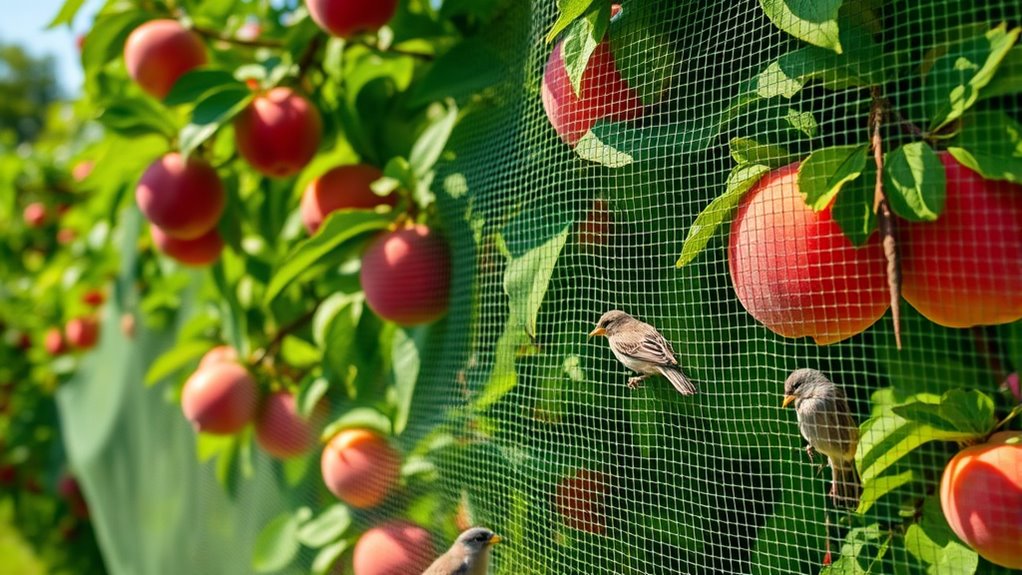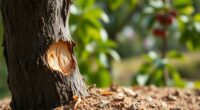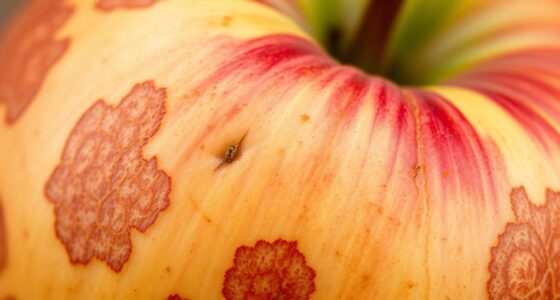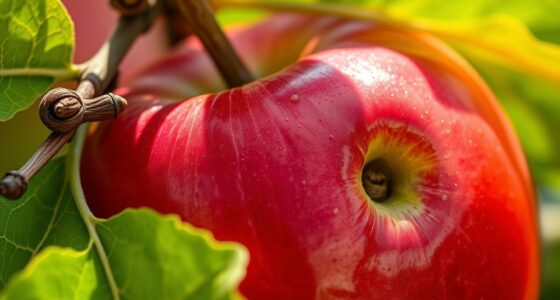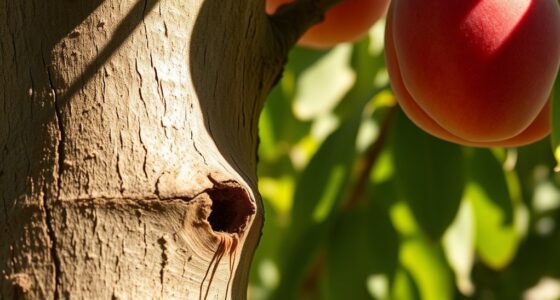To prevent bird damage to your fruit crops, using proper netting strategies is key. Choose lightweight, durable netting with small mesh sizes to keep out even tiny birds. Make sure to cover entire trees or clusters and secure all edges tightly to avoid gaps. Regular inspection and prompt repairs help maintain effectiveness throughout the season. Proper netting not only protects your harvest but also supports better fruit quality—keep going to discover more helpful tips.
Key Takeaways
- Choose lightweight, durable netting with small mesh sizes to effectively block small and large birds.
- Ensure complete coverage of trees and fruit clusters, extending netting to the ground for maximum protection.
- Secure netting edges tightly to prevent lifting, tearing, or bird access through gaps.
- Regularly inspect and promptly repair any tears or damages to maintain continuous bird exclusion.
- Proper installation and maintenance enhance harvest quality, reduce crop losses, and promote sustainable pest control.

Bird damage is a common problem for fruit growers, as many bird species are attracted to ripe, easily accessible fruit. If you’re experiencing significant losses, it’s time to contemplate effective netting strategies to protect your harvest. Netting provides a physical barrier that keeps birds away from your fruit, but the key to success lies in proper installation and maintenance. As you implement these strategies, it’s important to understand how netting fits into your overall pest control methods and how it can influence your harvesting techniques.
Bird damage often affects fruit crops; proper netting installation and maintenance are essential for effective protection.
When you’re setting up netting, start by choosing the right type for your crop and local bird species. Lightweight, durable netting with small mesh sizes works best, preventing even the smallest birds from slipping through. You’ll want to ensure the netting covers the entire tree or fruit cluster, extending to the ground if possible, to eliminate gaps that birds could exploit. Secure the edges tightly to prevent lifting or tearing, which could compromise the barrier. Proper installation minimizes the chances of birds finding access points, reducing the need for other pest control methods that might be less eco-friendly or more labor-intensive. Using netting can also influence your harvesting techniques. With a physical barrier in place, you’ll likely find it easier to predict when your fruit is ready for harvest, as the netting helps keep the fruit undamaged and undisturbed. You can harvest at peak ripeness, knowing the birds are kept at bay, which improves fruit quality and reduces losses. Additionally, netting allows you to time your harvests more precisely without chasing away birds or rushing to pick fruit before it’s overripe. This strategic approach can lead to better fruit preservation and higher market value. Moreover, integrating herbal infusers or other specialized tools can help maintain crop quality by reducing physical stress on the fruit during harvest. Incorporating netting into your pest control methods offers a sustainable, non-chemical way to protect your crops. Unlike repellents or scare devices, netting provides continuous protection without ongoing costs or the risk of birds adapting to deterrents. It also reduces the need for aggressive removal tactics and minimizes the impact on other wildlife. As you refine your harvesting techniques, be sure to regularly inspect and maintain your netting to prevent tears or gaps, especially after storms or strong winds. Doing so ensures your investment remains effective throughout the season, giving your fruit the best chance to reach consumers in top condition.
Frequently Asked Questions
How Do I Choose the Best Netting Material for My Orchard?
To select the finest netting material for your orchard, consider netting durability and material weight. Opt for a sturdy, UV-resistant net that can withstand weather and bird pecking. Lightweight options are easier to install but shouldn’t compromise strength. Balance durability with ease of handling to ensure long-lasting protection. Check reviews and consult suppliers to find a net that meets your orchard’s specific needs, ensuring your fruit stays safe from bird damage.
What Is the Cost Comparison Between Netting and Other Bird Deterrents?
Imagine protecting your orchard’s bounty without stretching your budget too thin. When comparing cost effectiveness and budget, netting often offers a more efficient solution over other bird deterrents like scare devices or loud noises. While initial investment may seem higher, netting provides long-lasting protection, reducing ongoing expenses. Overall, it’s a smart choice that balances upfront costs with sustained effectiveness, helping you safeguard your fruit while managing your budget wisely.
How Often Should Netting Be Inspected and Maintained?
You should inspect your netting at least once a week during the fruiting season to catch any tears or holes early. Regular maintenance tips include checking for loose or sagging sections, removing debris, and repairing any damage promptly. This proactive approach guarantees your netting remains effective in deterring birds and protects your crop throughout the season. Consistent inspections help prevent costly repairs and bird damage.
Are There Environmentally Friendly Netting Options Available?
Yes, you can choose biodegradable netting that’s gentle on the environment and compatible with organic farming. These eco-friendly options break down naturally, reducing waste and avoiding harmful chemicals. By opting for biodegradable netting, you support sustainable practices while protecting your produce from pesky birds. It’s a smart, responsible choice that combines environmental consciousness with effective bird deterrence, ensuring your fruit stays safe without sacrificing nature’s integrity.
Can Netting Be Reused After Harvest Season?
Yes, netting can be reused after harvest season if it has good durability and is properly maintained. You should check for signs of wear, tears, or UV damage that could compromise its reuse potential. When stored correctly in a dry, cool place, durable netting can last for multiple seasons. This not only saves you money but also reduces waste, making it an eco-friendly choice for protecting your fruit crops year after year.
Conclusion
Implementing netting strategies can drastically reduce bird damage, saving your fruit crop. Did you know that up to 80% of fruit loss can be prevented with proper netting? By investing in effective netting, you not only protect your harvest but also boost your yield and income. Don’t let birds steal your hard work—act now and secure your fruit with reliable netting solutions for a bountiful, damage-free harvest.
